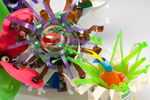Plastiquarium |
: recycled plastic art |
Frequently Asked Questions (FAQ)
Answers by David Edgar
How did you get started / what gave you the idea for this?
Having worked in formal fabricated steel sculpture for about 30 years, I was setting up my welding studio after having moved to Charlotte, NC from Ohio. It seems that the Carolina Panthers, the Charlotte hometown NFL team, made it to the Superbowl that year, and my wife, Robin, and I were invited to one of our new neighbor's houses to watch the game.
This was in February of 2004. Bereft of any Panthers logo wear to show some spirit, I fashioned a Carolina Panthers mask from part of a detergent bottle, plastic rotisserie chicken tray, bleach bottle, and some old chrome hardware. Made in the team's blue, black, silver and white colors scheme the mask was a hit. (The Panthers lost to the New England Patriots that year.)
In the weeks that followed I kept being attracted to the shapes and colors of the plastic containers I saw in neighbors recycling bins during our morning walks. One thing led to another and the Plastiquarium® was born.
How do you get those great colors / what kind of paint do you use?
The colors are not the result of any painting on my part; they are the colors of the plastic as I find it. I refer to these colors as "focus group approved colors" as the corporations surely select them through rigorous marketing research.
How do you cut the material?
Mostly with good quality sharp scissors. I find that Fiskars brand snips with titanium plated blades work very well. These are available at most big-box builders supply stores for around $12 - $15. I avoid using razor-bladed utility knifes if possible, although sometimes they are the best thing for certain applications. For really thick material of tight curves a pair of right and left cutting tin snips are good to have available. For more information about cutting this material, see our book, Fantastic Recycled Plastic.
How do you shape the material?
Heat-forming; I use a standard heat gun used for activating shrink-wrap and for stripping paint, etc. (An ordinary hair dryer will get hot enough for heat-forming plastic.) Note: always do this in a well-ventilated area and never heat plastic to the point of incineration as this will release toxic fumes. For more information about heat-forming this material, see our book, Fantastic Recycled Plastic.
How do you attach the material?
Mostly with mechanical fasteners like machine screws, pop rivets and staples. I avoid glue as much as possible as most glue does not work well with plastics. For more information about attaching this material, see our book, Fantastic Recycled Plastic.
Where do you get your material?
Mostly from recycling bins in my Charlotte, NC neighborhood on morning walks on recycle pick-up day. Of course, all of the material needs a through cleaning before going to the studio. (You would be surprised how much unused detergent people leave in the containers they put out for recycling.)
Do you teach workshops in this art form?
Yes! For further information, see the Workshops page.
Do you sell your work?
Yes! Both retail and wholesale.
Where can I find your work for sale?
The Society for Contemporary Craft, Pittsburgh, PA
The San Francisco Museum of Craft and Design, San Francisco, CA
The Peabody Essex Museum, Salem, MA
Some small works can be found online at my ETSY Shop.
Review the pricing information on this website and contact me directly at dallenedgar@gmail.com. Please include your telephone number.
[ top ]
